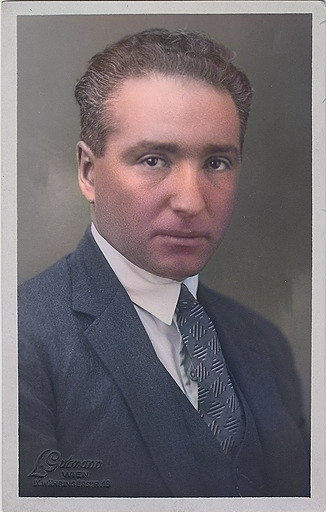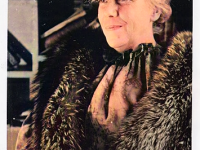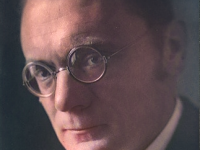
Wilhelm Reich (1897-1957)
On November 3, 1957, Austrian psychoanalyst Wilhelm Reich passed away. A member of the second generation of analysts after Sigmund Freud, Reich became known as one of the most radical figures in the history of psychiatry. He developed a system of psychoanalysis that concentrated on overall character structure, rather than on individual neurotic symptoms.
Wilhelm Reich – Early Years
Wilhelm Reich was born in 1897, the first of two sons of the landowner Léon Reich and his wife Cecilia. Reich’s birthplace, Dobzau, also known as Dobrzanica, was in what was then Austrian Galicia, while the village of Jujinetz (now in the Kizman rayon), where Reich spent most of his childhood, was in Bukovina. Reich’s parents were of Jewish origin but had broken away from the Jewish faith, so Reich received no religious education. He was taught at home by private tutors until he went to the German Gymnasium of Czernowitz. Shortly after the beginning of the World War, Reich was forced to abandon the estate and flee because of invading Russian troops. Wilhelm Reich joined the Austro-Hungarian Army during the First World War and became lieutenant at the Italian front with 40 men under his command.
Meeting Freud
After the war, Reich enrolled at the University of Vienna to study law and later switched to medicine. It is believed that Wilhelm Reich met Sigmund Freud for the first time in 1919 when he asked Freud for a reading list for a seminar concerning sexology.[4] Freud allowed him to start meeting with analytic patients in September that year, although Reich was just 22 years old and still an undergraduate, which gave him a small income. He was accepted as a guest member of the Vienna Psychoanalytic Association, becoming a regular member in October 1920, and began his own analysis with Isidor Sadger.
A Difficult Start
Lore Kahn became one of Wilhelm Reich’s first patients and despite Sigmund Freud’s warnings towards analysts not to involve themselves with their patients, Reich began an affair with Kahn. The woman later died and according to Reich, she died of sepsis after sleeping in a bitterly cold room she had rented as a place for her and Reich to meet. However, Kahn’s mother suspected that her daughter had died after a botched illegal abortion, possibly performed by Reich himself. Annie Pink, one of Kahn’s friends, became Reich’s fourth female patient. She was a medical student and also began an affair with Reich. They later got married and Anne became a well-known psychoanalyst herself.
“like a shark in a pond of carps“
Der triebhafte Charakter: Eine psychoanalytische Studie zur Pathologie des Ich (“The Impulsive Character: A Psychoanalytic Study of the Pathology of the Self“) became Wilhelm Reich’s first book and was published in 1925. In it, he studied the anti-social personalities he had encountered in the Ambulatorium, and argued the need for a systematic theory of character. The work was a success and increased Reich’s professional reputation. In 1927, Sigmund Freud arranged for his appointment to the executive committee of the Vienna Psychoanalytic Society. The appointment was made over the objection of Paul Federn, who had been Reich’s second analyst in 1922 and who, according to Sharaf, regarded Reich as a psychopath. Reich found the society dull and wrote that he behaved “like a shark in a pond of carps.“
Characters according to Freud, Fromm, and Reich
Sigmund Freud himself also published a paper on character and described the anal character consisting of stubbornness, stinginess, and extreme neatness. He saw this as a reaction formation to the child’s having to give up pleasure in anal eroticism. The positive version of this character is the conscientious, inner directed obsessive. Freud also described the erotic character as both loving and dependent. And the narcissistic character as the natural leader, aggressive and independent because of not internalizing a strong super-ego. On the other hand, Erich Fromm described character development as the way in which an individual structures modes of assimilation and relatedness.[5] Even though Fromm’s character types are quite similar to Freud’s, Fromm names them differently: receptive, hoarding, and exploitative. According to Wilhelm Reich, character structures are based upon blocks – chronic, unconsciously held muscular contractions against awareness of feelings. He further describes that a child learns to limit their awareness of strong feelings as their needs are thwarted by parents who meet cries for fulfillment with neglect or punishment. He argued for five basic character structures, each with its own body type developed as a result of the particular blocks created due to deprivation or frustration of the child’s stage-specific needs: the schizoid structure, the oral structure, the psychopath, the masochist structure, and the rigid or perfectionist. It is believed that Erich Fromm got his ideas about character structure from Sándor Ferenczi and Wilhelm Reich. Wilhelm Reich then developed the concept from Ferenczi, and added to it an exploration of character structure as it applies to body structure and development as well as mental life.
Emigration
On March 2, 1933, an inflammatory article against Reich’s writing Der sexuelle Kampf der Jugend (The sexual struggle of youth) appeared in the Völkischer Beobachter. The next day Reich emigrated with his wife Annie, first to Vienna and then to Copenhagen. During the book burning planned and orchestrated by the Nazi regime on May 10, 1933, his books were burned. In 1934 Reich lost his residence permit for Denmark, so he emigrated to Norway and settled in Oslo. In August 1939, shortly before the beginning of World War II, Reich moved to New York with his laboratory, which was only possible because he had received a teaching position at the New School for Social Research.
Orgone Research
Reich had sought the teaching position only to obtain a visa to the United States. He carried it out only for one year. Parallel to this and afterwards, he concentrated on orgone research, building on his bionics research of the Oslo period. His work led him to the postulate of a “specifically biological” energy, which he called orgone. According to Reich, this could be concentrated in orgone accumulators constructed by him and was the biophysical basis of his therapy. Under the impression of the Korean War, in which the use of atomic bombs was also considered, Reich began the “Oranur Experiment” in January 1951, with which he wanted to research whether radioactivity could be neutralized with orgone energy.[22] After experimental mice unexpectedly died and several employees became seriously ill, Reich evacuated his laboratory building to prevent further damage.
Final Years
In 1955 a court ordered a ban on the use of orgone accumulators and the destruction of the devices and all his books. This was not accepted by Reich, because it was a scientific question which could not be settled by a court. In 1956, after one of Reich’s associates violated the court’s ban on transporting orgone accumulators across U.S. state lines, Reich was sentenced to two years in prison for “contempt of court.” Reich began the sentence on March 12, 1957, and died while in prison on November 3, 1957. The cause of death was given as heart failure.
Radical thinkers: Wilhelm Reich’s Sex-Pol, [10]
References and Further Reading:
- [1] Wilhelm Reich Biographical
- [2] Wilhelm Reich Character Analysis
- [3] Wilhelm Reich’s Character Structures
- [4] Freudian Slips and other Trifles, SciHi Blog
- [5] Erich Fromm and the Frankfurt School of Critical Theory, SciHi Blog
- [6] Brady, Mildred Edie (26 May 1947). “The Strange Case of Wilhelm Reich”, The New Republic.
- [7] Elkind, David (18 April 1971). “Wilhelm Reich – The Psychoanalyst as Revolutionary; Wilhelm Reich” The New York Times.
- [8] Turner, Christopher (8 July 2011). “Wilhelm Reich: the man who invented free love” Archived, The Guardian.
- [9] Wilhelm Reich at Wikidata
- [10] Radical thinkers: Wilhelm Reich’s Sex-Pol, The Guardian @ youtube
- [11] Timeline of Psychoanalysis from Vienna





